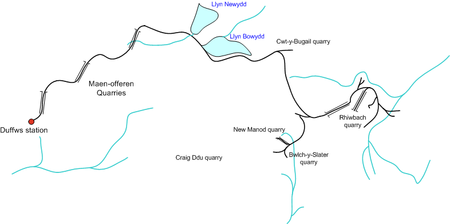Rhiwbach Tramway
1861 establishments in Wales1 ft 11½ in gauge railways in WalesBro MachnoFfestiniogFfestiniog Railway ... and 5 more
Horse-drawn railwaysIndustrial railways in WalesRailway inclines in WalesRailway lines opened in 1863Use British English from October 2017

The Rhiwbach Tramway was a Welsh industrial, 1 ft 11+1⁄2 in (597 mm) narrow gauge railway connecting the remote slate quarries east of Blaenau Ffestiniog with the Ffestiniog Railway. It was in use by 1862, and remained so until progressively closed between 1956 and 1976. The route included three inclines, one of which became the last operational gravity incline in the North Wales slate industry. The tramway was worked by horses and gravity for much of its existence, but a diesel locomotive was used to haul wagons on the top section between 1953 and its closure in 1961.
Excerpt from the Wikipedia article Rhiwbach Tramway (License: CC BY-SA 3.0, Authors, Images).Rhiwbach Tramway
Geographical coordinates (GPS) Address Nearby Places Show on map
Geographical coordinates (GPS)
| Latitude | Longitude |
|---|---|
| N 53.0022 ° | E -3.9035 ° |
Address
Ffestiniog
, Ffestiniog
Wales, United Kingdom
Open on Google Maps











